First World War Project
Ernest Cecil KEMP (of Lynsted)
b. 22nd July 1888 Able Seaman, Service Number J/16643 |
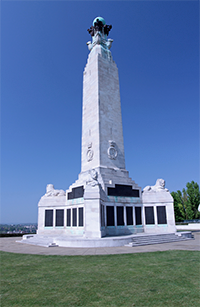

Ernest was the eldest child of William Ernest, a saddler and harness maker in Greenstreet (now No 118 London Road), Lynsted, and Mercy Annie (née Kenton). The Kemps had been master saddlers and harness-makers in Greenstreet since the 1840s and William Ernest took over the business from his father, William Jeremiah, by 1901. Ernest was born on 28 June 1896 and christened in Lynsted Church on 6 September the same year. His younger siblings were Elnith Kenton, Audrey Alice, Arthur William, Frank John and Evelyn Mercy. Sadly one child, Percy William, who was born in 1902, lived only a few months.
The Society is indebted to Ernest's nephew, David Aggersberg, who has kindly allowed us to reproduce his own research below. This far better tells the story of Ernest than we would have been able:
"It seems that life as a saddler's apprentice in the subterranean workroom beneath his father's shop did not appeal to Ernest Cecil, as he was enrolled in the Royal Navy as a boy seaman on 20 March 1912. His service record shows him as being 5ft 7in tall with a chest measurement of 34½in. His eyes were grey-brown and complexion "very fresh". His previous occupation was given as fruit-picker. The decision to join the Navy was probably influenced by his uncle, Victor Edward Kemp, who had served from 1885 to 1907 reaching the rank of Chief Stoker.
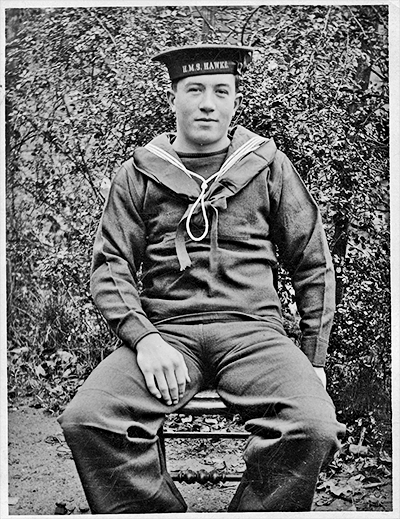 Ernest Cecil appears to have flourished in the Royal Navy, as by 1914 his chest measurement had reached 40½in! HMS Ganges, the Navy's boy seamen establishment, was located at Shotley in Suffolk. On entry he was rated as Boy 2nd Class being advanced to Boy (lst Class) in October 1912. On 16 June 1913 he was drafted to HMS Hawke, an elderly protected cruiser used for training purposes following a serious collision with RMS Olympic in the Solent during 1911.
Ernest Cecil appears to have flourished in the Royal Navy, as by 1914 his chest measurement had reached 40½in! HMS Ganges, the Navy's boy seamen establishment, was located at Shotley in Suffolk. On entry he was rated as Boy 2nd Class being advanced to Boy (lst Class) in October 1912. On 16 June 1913 he was drafted to HMS Hawke, an elderly protected cruiser used for training purposes following a serious collision with RMS Olympic in the Solent during 1911.
Service on HMS Hawke ended on 12 March 1913 and Ernest Cecil then spent some time at Chatham naval base before being sent to HMS Essex, a more modern protected cruiser, on 1 January 1914. Rated as an Ordinary Seaman, the following month he was promoted to Able Seaman in September of the same year.

Ernest Cecil kept in touch with his mother by a series of postcards sent in addressed envelopes which she supplied. Only a few of these survive, but they cover an interesting episode in the deployment of H.M.S. Essex to the West Indies in 1914. During this period the United States of America was having considerable difficulties with Mexico which was convulsed by revolution. An incident involving American sailors in Tampico was followed by the reported imminent arrival of an arms shipment to the port of Vera Cruz.
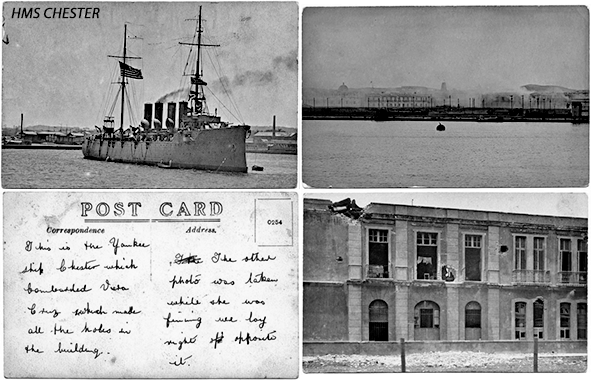
President Wilson ordered the occupation of the port as a reprisal and a force of American sailors and marines landed on 21 April 1914. The Mexicans resisted and a naval bombardment of the waterfront occurred the following day. The British government, no doubt concerned about British lives and interests, despatched H.M.S. Essex to the scene, although she took no part in the action. Ernest Cecil's postcards show the bombardment and the resulting damage ashore.
Service on H.M.S. Essex was completed in April 1915 and Ernest Cecil spent another eight months atChatham before being sent ,on 4 January 1916, to H.M.S. Egmont, the naval base at Valletta, Malta. On arrival he was assigned to the crew of H.M.S. Primula, a minesweeping sloop of 1250 GRT, completed in January 1916 by Swan Hunter and carrying two 4in guns.
On 1 March 1916 while steaming south of Cape Matapan near Cerigo island H.M.S. Primula (right) was torpedoed by the German submarine U-35 commanded, since 18 November 1915, by Kapitanleutnant Lothar von Arnauld de la Perière. German U-boats had been deployed to the Mediterranean during 1915 to support the Austro-Hungarian navy and were based at ports on the Adriatic.
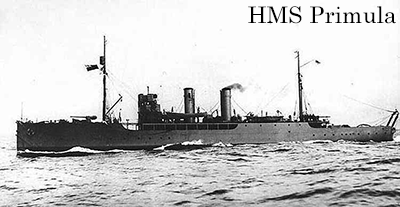 The first torpedo struck the bow of the minesweeper, but the internal bulkheads held. Unable to go ahead H.M.S. Primula turned and repeatedly attempted to ram the submarine stern first. Two more torpedoes from the U-35 missed before a third found its target and the ship sank. Ernest Cecil Kemp was one of three ratings killed. There were 107 survivors. Lothar von Arnauld de la Perière paid his own tribute to his opponent — "Four torpedoes for that tiny wasp!"
The first torpedo struck the bow of the minesweeper, but the internal bulkheads held. Unable to go ahead H.M.S. Primula turned and repeatedly attempted to ram the submarine stern first. Two more torpedoes from the U-35 missed before a third found its target and the ship sank. Ernest Cecil Kemp was one of three ratings killed. There were 107 survivors. Lothar von Arnauld de la Perière paid his own tribute to his opponent — "Four torpedoes for that tiny wasp!"
Victor Edward Kemp, his uncle, was recalled to Royal Navy active service with the rank of Chief Stoker in June 1915 and served until February 1919. He returned to live in Greenstreet.
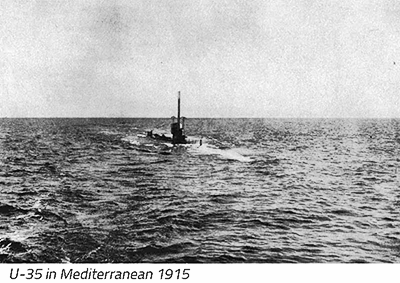 U-35 survived the First World War, having returned to Germany in October 1918. The submarine surrendered to the Royal Navy at Harwich on 27 November 1918. Lothar von Arnauld de la Perière returned to Germany in May 1918 to command U-139. During the First World War submarines under his command sank 453,716 tons of Allied shipping and he earned a reputation for the scrupulous observation of the rules of war. Vice-Admiral Lothar von Arnauld de la Perière, Kriegsmarine commander for Western France, died in a plane crash at Le Bourget on 24 February 1941. His record as the most successful submarine commander from any navy still stands."
U-35 survived the First World War, having returned to Germany in October 1918. The submarine surrendered to the Royal Navy at Harwich on 27 November 1918. Lothar von Arnauld de la Perière returned to Germany in May 1918 to command U-139. During the First World War submarines under his command sank 453,716 tons of Allied shipping and he earned a reputation for the scrupulous observation of the rules of war. Vice-Admiral Lothar von Arnauld de la Perière, Kriegsmarine commander for Western France, died in a plane crash at Le Bourget on 24 February 1941. His record as the most successful submarine commander from any navy still stands."
| East Kent Gazette of 11 March 1916 |
| A GREENSTREET SAILOR DROWNED. The sad news has been received of the death of Able Seaman Ernest C. Kemp, of HMS Primula, a minesweeper, that was carrying out patrol duties in the Eastern Mediterranean last week. The whole of the officers and men were saved and landed at Port Said, with the exception of three – and one of the three men reported by the Admiralty as "missing, believed to be dead" is Ernest C. Kemp. The young man who was in his 20th year, was the oldest child of Mr and Mrs Ernest Kemp, of Greenstreet. He was a finely built young fellow, and was making rapid strides in the Navy, and his death while serving his country is deeply regretted. The deceased was very popular in the village, and much sympathy is felt for the parents and members of the bereaved family. |
| Faversham and North East Kent News of 18th November 1916 |
| Among the crew of HMS Primula, a mine sweeper which was torpedoed recently while carrying out patrol duties in the Eastern Mediterranean, was Able Seaman Ernest C. Kemp, son of Mr. and Mrs. Ernest Kemp, of Greenstreet, and we regret to note that he is one of the 3 men reported by the Admiralty as "missing, believed to be dead." With the exception of only these three all the officers and men of the vessel were saved and landed at Port Said. Seaman Kemp, who was in his 20th year, was a splendid young fellow and was making good headway in the Navy. |
Ernest was posthumously awarded the British and the Victory Medals. [See Appendix 1]. His body was not recovered but he is remembered on the Chatham Naval Memorial. Panel 16
He is also remembered on his Mother, Father and Brother's headstone in the Graveyard Extension of Lynsted Church.
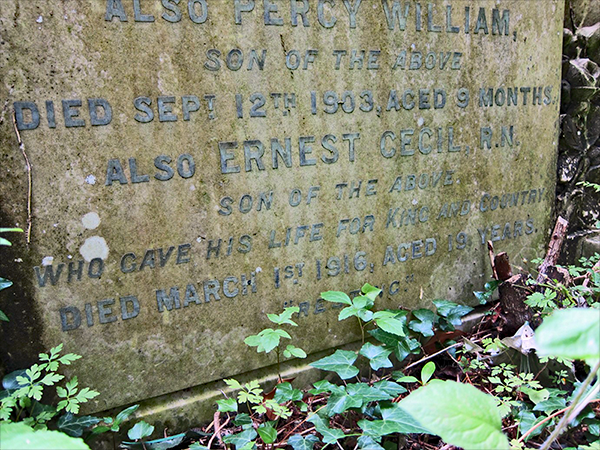

 World War 1 Pages
World War 1 Pages